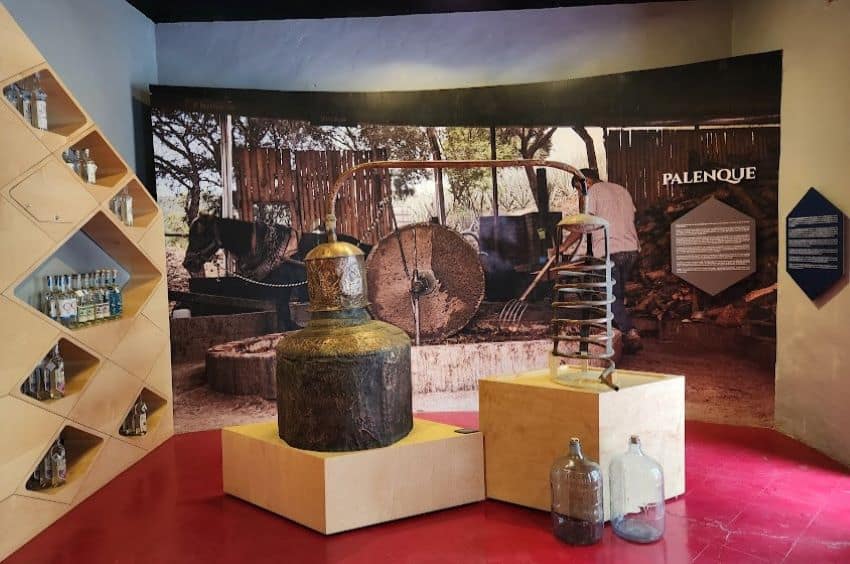If you are a mezcal enthusiast, connoisseur, or simply curious, you should know that there’s a new and very complete museum in Oaxaca dedicated to this fascinating drink. The Centro Cultural del Mezcal in Oaxaca city is a mezcal mecca: inaugurated this past October, it features more than 350 different labels of mezcal. It is the only place in Mexico and the world where you can find such an amount and variety of mezcal to taste, learn about and buy.
The center is a museum, a store and a restaurant all rolled into one. Inside the building, you’ll find a traditional Mexican courtyard — home to the center’s restaurant — surrounded by rooms filled with information, devices and pictures that tell the story of how mezcal is made.

Each exhibition room offers an exploration of the history and production process of mezcal from various perspectives. When entering the museum, you have the option of purchasing a 170-peso “passport” which allows you to taste a wide selection of mezcals as you go through the rooms and learn more about the drink.
The cultural center displays different colors of mezcal, both for taste and for show; mezcals bottled with scorpions, insects, or snakes; and mezcals infused with a variety of animal meats, such as mezcal de pechuga — chicken or turkey breast mezcal. You’ll find bottles from brands that produce around 1,000 bottles per batch — like 400 Conejos, Creyente, Amarás and Montelobos — to more artisanal brands that produce 80 to 100 bottles per batch.
During your visit, you can learn about:
- The difference between artisanal, ancestral and traditional mezcal.
- The different types of magueyes used in mezcal production, such as the usual espadín, tobalá, cuishe, and other lesser-known varieties.
- How different devices are used during the production process, some of which are physically part of the exhibition rooms.
- How to read a mezcal label anywhere to know what you’re buying and if it’s authentic mezcal.
Master mezcaleros

Center to this museum’s story are maestros mezcaleros, the master artisans and craftspeople who dedicate their lives to the elaborate process of producing this drink. “Our idea is to empower the maestro mezcalero, to celebrate their product as a very high-quality product, and make them proud of that,” says Itzel Paniagua, the cultural center’s owner.
Oaxaca is the leading producer and exporter of mezcal in Mexico, accounting for 96.1% of the exported mezcal. The seven different regions that produce mezcal in the state have been strengthened since the recognition of mezcal’s appellation of origin in 1994.
The mission of the museum is to further empower master mezcaleros by working directly with them to sell and showcase their labels. By doing this, they are able to make the purchase and consumption of their mezcales more straightforward, as well as celebrate their work with the information offered at the museum.
Thanks to this initiative, they have fostered relationships with over 86 groups of master mezcaleros.
Comercam certification
All of the bottles showcased and sold at this museum are certified by the Mexican Regulatory Council for Mezcal Quality (COMERCAM), ensuring the mezcal has passed through rigorous and specific steps concerning its alcohol content, distillation process bottling, and labeling processes, etc. All brands, except for two from Puebla, come from Oaxaca.
Where it is and who will guide you
The center is located inside a classic example of a 17th-century colonial mansion in Oaxaca’s celebrated and colorful downtown. Prior to housing the Centro Cultural del Mezcal, the building has served as a house, the Arts and Sciences Institute of Oaxaca, a hardware store that used to sell bottles of a wine-mezcal combination and a bank.
Throughout your visit, you’ll be shown through the space’s various rooms by a museum guide. The guides have received highly curated training from different books and authors, as well as directly from some mezcal brands. They have extremely specialized and in-depth knowledge of the different labels and processes in which all varieties of mezcal are made. What’s more, they can recommend different mezcal bottles for you to try or buy depending on your specific tastes and interests.
Make sure you make the most out of this expertise, and ask them lots of questions!
Where to find more mezcal and how to get one of these bottles
If you’re in Mexico City, you can find 50 of these mezcal labels at Taller Gastronómico in San Ángel, a cooking workshop business owned also by Itzel Paniagua.
Additionally, the center can ship mezcal bottles to anywhere in Mexico. You can contact them via their website or through Whatsapp, at +52 1 951 579 1726.
Montserrat Castro Gómez is a freelance writer and translator from Querétaro, México.
